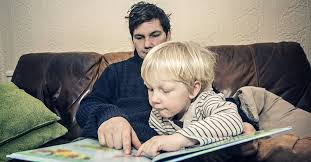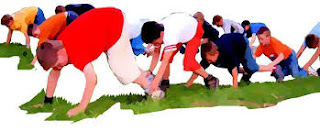Crossing Midline refers to the ability to move from one side of the body
to the other and it is a very important skill to develop! Midline Crossing
occurs in the Transverse plane of the body and incorporates bilateral
coordination and rotation. It is needed
for almost all our daily movements like getting dressed, throwing a ball, closing
a door, crossing a street.
The brain is divided into 2 hemispheres that control the left and right
sides of our body and carry out different functions. Each hemisphere
communicates with the other across the corpus
callosum, which is a mass of tissue that connects the 2 parts of the
brain, allowing smooth, coordinated movements.
Bilateral coordination is the ability to move both sides of the body
together and starts developing in infancy and continues to progress through childhood.
The two sides of the body learn to work together (banging toys, pushing,
pulling), in an alternating pattern (crawling and walking) and then doing
different things with each side of the body (holding a book with one hand and
turning pages with the other or holding a paper while coloring or cutting). Children learn to coordinate between a
stronger (dominant) hand and an assisting (non-dominant) hand. When both sides
of the brain are sharing information and communicating well, a child can move
in a smooth, coordinated way.
If a person is unable to cross the midline, it might be an indication
that there is poor communication between the right and left hemispheres. If a
child doesn’t cross midline, they may be delayed in developing a dominant
hand. They may have difficulty rolling
from back to tummy, swinging a bat, throwing overhand, kicking a ball, and many
more activities.
If a child lacks good core control of the “stabilizing muscles” of the
trunk and has difficulty rotating their trunk, they will have difficulty
crossing the midline of their body as well. When they can’t rotate their trunk,
they can’t cross their midline.
You might suspect issues with midline crossing if you see your child hold
themselves stiffly and turn with their entire body rather than rotate through
their center axis to reach something to one side. You may see them pick up an
object and pass it to the other hand in order to reach the other side of their
body. You may see a child turn their
paper when writing so they do not have to cross midline.
What can be done for a child who does not appear to have good bilateral skills and is not crossing midline well?
An evaluation by a Physical or Occupational Therapist is a good idea if
you note problems or are concerned. Your
therapist will give you lots of advice, exercises and ideas to try. You might
also enjoy some of the following activities.
Activities to Encourage Midline Crossing:
- Play games requiring a child to pick up a card, lego, or puzzle piece from one side of their body and place it on the other side. You may need to gently hold down a hand so that the other hand can reach across your child’s body. (See ProEducationalToys for Great Block Sets!)
- Have your child hold a large book centered in their lap. Encourage them to reach across their body with one hand and turn the page. Alternate hands with each page turn.
- When children are writing or coloring, encourage the non-dominant or assisting hand to rest on the table and holding the paper. Keep the paper in the middle, centered above a line drawn from the belly button to the chin.
- Work on a vertical surface like a chalkboard, easel, or white board. (SEE OUR ARTICLE ON THE BENEFITS OF PLAYINGON A VERTICAL SURFACE!!!) Make sure that your child is positioned in the middle of the work surface and that they are, indeed, reaching across midline. Place their non-dominant or assisting hand on the surface, as well. Have them draw a large “X” from the top and bottom of each corner of their work space. Make a colorful rainbow from one side to the other.
- Play catch and throw games with balls and bean bags. (SEE OUR 3-PART ARTICLE ON HOW BALL SKILLS DEVELOP IN CHILDREN, and choose an activity appropriate for your child). Place a large cardboard box as a target in front and to one side of the child. Encourage them to throw using the hand opposite the box so that they will need to cross midline. Then switch the box to the opposite side and use the other hand. Make sure that they are standing in one spot and rotating across their body.
- Play “Flashlight Tag” in a darkened room. You will need a flashlight for each person. Sit together with your child, backs against a wall (to help keep them from turning with their whole body!). Move your flashlight and have your child “chase” the light with theirs. Practice diagonals and other patterns that encourage crossing midline.
- Several children or adults can play the “Caterpillar Game”. Each player bends forward to take hold of the ankles of the child in front of them. As the leader gives the command, “Left, right”, each child moves that leg forward, and consequently carrying the arm of their playmate behind them, enabling the caterpillar to crawl forward. If children do not yet know left and right, you could have the leader stand in front of the caterpillar and alternate holding up a piece of red paper and blue paper and call, “Red side, Blue side”. Children can sit, squat, or get on all fours to play a variant form of the same game.
Blog Administrator: Trisha Roberts
proeducationaltoys@gmail.com
Copyright © 2017 TNT Inspired Enterprise, LLC, All rights reserved.
Unauthorized duplication is a violation of applicable laws.
















No comments:
Post a Comment